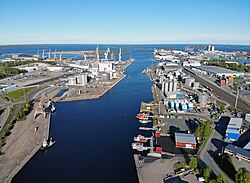
The Finnish maritime cluster is a cluster of Finnish companies in maritime industries. In 2016 the total turnover was estimated at 13 billion euros and it employed 48,000 people. [1]

The Finnish maritime cluster is a cluster of Finnish companies in maritime industries. In 2016 the total turnover was estimated at 13 billion euros and it employed 48,000 people. [1]
Small trading ships similar to Jacobstads Wapen were built in Finnish coastal towns in the 18th century. Small-scale shipyards continued to exist well into the 20th century. The first large scale shipyard was the galley dry dock at Sveaborg built in the mid-18th century, which serviced the ships that won one of the largest sea battles in Finnish history.
The first industrial scale shipyard in Turku was established in 1732. After the Crimean War, William Crichton acquired a workshop and built a new shipyard, which later absorbed smaller shipyards and developed into Crichton-Vulcan and merged with Wärtsilä between 1936 and 1938. Germany outsourced a notable amount of submarine construction to Finland after World War I. This section of industry was later outlawed by the Paris Peace Treaty, but it became an important foundation for the Finnish maritime industry. [2]
A major boost to Finnish shipbuilding was the war reparations paid to the Soviet Union after World War II. They forced a rapid industrialization of Finland and the creation of a large metal industry in addition to the traditional papermaking and forest industries. [3] By 1953, the shipbuilding industry had six times the capacity it did in 1944. [4]
Bilateral trade with the Soviet Union forced Finnish shipyards to build ships with a high percentage of total value of Finnish origin.[ citation needed ] All major components of the finished products needed to be produced domestically. The high percentage of domestic components continues even after the dissolution of the Soviet Union and the end of the lucrative trade deals. While ships built in other European shipyards are a collection of components from around Europe and around the world, ships built in Finland can have up to 90% of their total value in Finnish components and labor (kotimaisuusaste). [5] [6] [7] [8] [9] [10] [11] [12]



Laivan kotimaisuusaste on noin 90 prosenttia.
kotimaisuusaste on 85-90 prosenttia
Projektin kotimaisuusaste on korkea.
Uuden satamajäänmurtajan suunnittelu, potkurilaitteistot, pääkoneet, teräsmateriaalit sekä suurin osa työstä tulevat Suomesta. Hankinnan kotimaisuusaste onkin korkea, arviolta 85 prosenttia.
{{cite web}}: Missing or empty |url= (help)Aluksen kotimaisuusaste on 80 %[ permanent dead link ]
hankkeen kotimaisuusaste on 80 prosenttia.
Tällaisten tilausten kotimaisuusaste on peräti 80 prosenttia.
Suomessa rakennettujen laivojen kotimaisuusaste on 80–90 prosenttia.